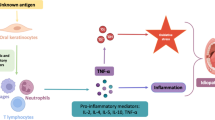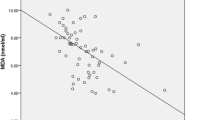Abstract
There has recently been growing evidence supporting the importance of oxidative stress in the pathogenesis of Behçet’s disease (BD). In this study, we aim to evaluate total antioxidant status (TAS) and total oxidative stress (TOS) in BD patients, and compare their results both with controls that had recurrent aphthous stomatitis (RAS) and healthy controls. TAS statistically decreased in RAS patients, and TOS levels increased in BD and RAS patients than those in healthy controls. The serum levels of Cu significantly increased only in BD patients when compared with healthy controls. Fe levels were not statistically different among the BD patients, RAS patients and healthy controls, but there was a positive correlation between TOS and plasma Fe levels in BD patients. Our results suggest that there is an insufficient antioxidant system and increased oxidative status both in BD and RAS patients. The antioxidant supplementations in addition to medical treatments will improve the quality of life.
Similar content being viewed by others
References
Onder M, Gurer MA (2000) The multiple faces of Behçet’s disease and its etiological factors. J Eur Acad Dermatol Venereol 15:126–136
Ghate JV, Jorizzo JL (2001) Behçet’s disease Kelley’s textbook of rheumatology. Saunders, Philadelphia, pp 1205–1209
Yurdakul S, Yazici H, Tuzun Y, Pazarli H, Yalcin B, Altac M, Ozyazgan Y, Tuzuner N, Muftuoglu A (1983) The arthritis of Behçet’s disease: prospective study. Ann Rheum Dis 42:505–515
Kim HA, Choi KW, Song YW (1997) Arthropathy in Behçet’s disease. Scand J Rheumatol 26:125–129
Benamour S, Zeroual B, Alaoui FZ (1998) Joint manifestations in Behçet’s disease: a review of 340 cases. Rev Rhum Engl Ed 65:299–307
Porter SR, Hegarty A, Kaliakatsou F, Hodgson TA, Scully C (2000) Recurrent aphthous stomatitis. Clin Dermatol 18:569–578
Karincaoglu Y, Batcioglu K, Erdem T, Esrefoglu M, Genc M (2005) The levels of plasma and salivary antioxidants in the patient with recurrent aphthous stomatitis. J Oral Pathol Med 34:7–12
Onder M (2001) Oral aphthous. Medical education of dermatologist represented meeting, Greece, pp 35–39
Marshall Sara E (2004) Behçet’s disease Best practice and research. Clin Rheumatol 18(3):291–311
Babior BM (2000) Phagocytes and oxidative stress. Am J Med 109:33–44
Iijima S, Otsuka F (1997) Peripheral blood neutrophil rheology measured by microspore filtration reflects Behçet’s disease activity well. J Dermatol Sci 15:44–50
Sies H (1997) Oxidative stress: oxidants and antioxidants. Exp Physiol 82:291–295
Serafini M, Del Rio D (2004) Understanding the association between dietary antioxidants, redox status and disease: is the total antioxidant capacity the right tool?. Redox Rep 9(3):145–152
Llesuy S, Evelson P, Campos AM, Lissi E (2001) Methodologies for evaluation of total antioxidant activities in complex mixtures A critical review. Biol Res 34(2):51–73
International Study Group for Behçet’s Disease (1990) Criteria for diagnosis of Behçet’s disease. Lancet 335:1078–1080
Verde V, Fogliano V, Ritieni A, Maiani G, Morisco F, Caporaso N (2002) Use of N,N-dimethyl-p-phenylenediamine to evaluate the oxidative status of human plasma. Free Radic Res 36(8):869–873
Miller NJ, Rice-Evans C, Davies MJ, Gopinathan V, Milner A (1993) A novel method for measuring antioxidant capacity, and its application to monitoring antioxidant status in premature neonates. Clin Sci 84:407–412
Henry RJ, Cannon D, Winkleman JW (eds) (1974) Clinical Chemistry principles and technica, 2nd edn, Harper and Row, London, pp 699–705
Halliwell B, Whiteman M (2004) Measuring RS and oxidative damage in vivo and in cell culture: how should you do it and what do the results mean?. Br J Pharmacol 142:231–255
Dotan Y, Lichtenberg D, Pinchuk I (2004) Lipid peroxidation cannot be used as a universal criterion of oxidative stress. Prog Lipid Res 43(3):200–227
Therond P, Bonnefont-Rousselot D, Davit-Spraul A, et al. (2000) Biomarkers of oxidative stress: an analytical approach. Curr Opin Clin Nutr Metab Care 3:373–384
Kokcam I, Nazıroglu M (2002) Effects of vitamin E supplementation on blood antioxidants levels in patients with Behçet’s disease. Clin Biochem 35(8):633–639
Yazici C, Kose K, Calis M, Demir M, Kirnap M, Ates F (2004) Increased advanced oxidation protein products in Behçet’s disease: a new activity marker. Br J Dermatol 151(July):105
Bekpinar S, Kilic N, Unlucerci Y, Akdag-Kose A, Azizlerli G, Ozbek-Kir Z (2005) Evaluation of nitrosative and oxidative stress in Behcet disease. J Eur Acad Dermatol Venereol 19(2):167–171
Yardim-Akaydin S, Sepici A, Ozkan Y, Simsek B, Sepici V (2006) Evaluation of allantoin levels as a new marker of oxidative stress in Behcet’s disease. Scand J Rheumatol 35(1):61–64
Matés JM (2000) Effects of antioxidant enzymes in the molecular control of reactive oxygen species in toxicology. Toxicology 153:83–104
Wang XL, Rainwater DL, VandeBerg JF, Mitchell BD, Mahaney MC (2001) Genetic contributions to plasma total antioxidant activity. Arterioscler Thromb Vasc Biol 21:1190–1195
Orem A, Yandi YE, Vanizor B, Cimsit G, Uydu HA, Malkoc M (2002) The evaluation of autoantibodies against oxidatively modified low-density lipoprotein (LDL), susceptibility of LDL to oxidation, serum lipids and lipid hydroperoxide levels, total antioxidant status, antioxidant enzyme activities, and endothelial dysfunction in patients with Behçet’s disease. Clin Chem 35:217–224
Pronai L, Ichikawa Y, Nakazawa H, Arimori S (1991) Enhanced superoxide generation and the decreased superoxide scavenging activity of peripheral blood leukocytes in Behçet’s disease effects of colchicine. Clin Exp Rheumatol 9:227–233
Author information
Authors and Affiliations
Corresponding author
Rights and permissions
About this article
Cite this article
Sepici-Dinçel, A., Özkan, Y., Yardim-Akaydin, S. et al. The association between total antioxidant status and oxidative stress in Behçet’s disease. Rheumatol Int 26, 1005–1009 (2006). https://doi.org/10.1007/s00296-006-0126-3
Received:
Accepted:
Published:
Issue Date:
DOI: https://doi.org/10.1007/s00296-006-0126-3




